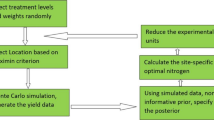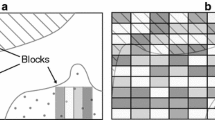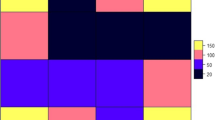Abstract
For many decades, researchers have relied on small-scale agronomic experiments to provide input management recommendations to farmers. However, such experiments have most often provided production functions with large standard errors in addition to uncertainty about how well the estimates apply to different fields. To avoid such limitations, there has been a movement toward on-farm field experiments where experiments are conducted on the whole field. But questions remain as how best to conduct these on-farm field experiments and when it is most profitable to quit them. This study addressed these questions using a fully Bayesian decision-theoretic approach. Data were from Monte Carlo simulations assuming a linear response stochastic plateau production function from one field. Only uniform rate application was considered. The base model had corn and N prices of $0.116 kg−1 and $0.993 kg−1 and used 100 plots with an experimental design that allocated 10 plots to 0 kg of N, half of current optimal N (N*), and 150% of N*, with 70 using N*. With the base model, it was most profitable to quit such trials in year two. Sensitivity analysis suggested that the optimal strategy was to experiment on fewer plots, use levels of N closer to the optimum, and continue the experiment for longer than was done with the base model. These changes reduced losses from using nonoptimal levels of nitrogen. The assumptions used in the base model, however, might be more economical if plot sizes were small and so a smaller percentage of plots were used for experimentation.


Similar content being viewed by others
Data availability
Not relevant.
Code availability
The R programming code used here is available from the corresponding author.
References
Ackello-Ogutu, C., Paris, Q., & Williams, W. A. (1985). Testing a von Liebig crop response function against polynomial specifications. American Journal of Agricultural Economics, 67(4), 873–880. https://doi.org/10.2307/1241829
Babcock, B. A., & Pautsch, G. R. (1998). Moving from uniform to variable fertilizer rates on Iowa corn: Effects on rates and returns. Journal of Agricultural and Resource Economics, 23, 385–400.
Berger, J. O. (2013). Statistical decision theory and Bayesian analysis. Springer-Verlag.
Boyer, C. N., Larson, J. A., Roberts, R. K., McClure, A. T., Tyler, D. D., & Zhou, V. (2013). Stochastic corn yield response functions to nitrogen for corn after corn, corn after cotton, and corn after soybeans. Journal of Agricultural and Applied Economics, 45, 669.
Bullock, D., & Mieno, T. (2017). An assessment of the value of information from on-farm field trials. Unpublished working paper, University of Illinois, Champaign, IL.
Bullock, D. S., & Mieno, T. (2019). The economic value of on-farm precision experimentation. In J. V. Stafford (Ed.), Precision agriculture’19 (pp. 327–342). Wageningen Academic Publishers.
Brorsen, B. W., & Richter, F. G. C. (2012). Experimental designs for estimating plateau-type production functions and economically optimal input levels. Journal of Productivity Analysis, 38(1), 45–52. https://doi.org/10.1007/s11123-010-0204-0
Casanoves, F., Macchiavelli, R., & Balzarini, M. (2007). Models for multi-environment yield trials with fixed and random block effects and homogeneous and heterogeneous residual variances. The Journal of Agriculture of the University of Puerto Rico, 91(3–4), 117–131.
Cerrato, M. D., & Blackmer, A. M. (1990). Comparison of models for describing corn yield response to nitrogen fertilizer. Agronomy Journal, 82, 138–143. https://doi.org/10.2134/agronj1990.00021962008200010030x
Denwood, M. J. (2016). runjags: An R package providing interface utilities, model templates, parallel computing methods and additional distributions for MCMC models in JAGS. Journal of Statistical Software, 71(9), 1–25. https://doi.org/10.18637/jss.v071.i09
Dhakal, C., Lange, K., Parajulee, M. N., & Segarra, E. (2019). Dynamic optimization of nitrogen in plateau cotton yield functions with nitrogen carryover considerations. Journal of Agricultural and Applied Economics. https://doi.org/10.1017/aae.2019.6
Drovandi, C. C., & Tran, M. N. (2018). Improving the efficiency of fully Bayesian optimal design of experiments using randomised quasi-Monte Carlo. Bayesian Analysis, 13(1), 139–162. https://doi.org/10.1214/16-BA1045
Gelman, A., Stern, H. S., Carlin, J. B., Dunson, D. B., Vehtari, A., & Rubin, D. B. (2013). Bayesian data analysis (3rd ed.). Chapman and Hall/CRC.
Gelman, A., & Rubin, D. B. (1992). Inference from iterative simulation using multiple sequences. Statistical Science, 7(4), 457–472. https://doi.org/10.1214/ss/1177011136
Griffin, T., Fitzgerald, G. J., Lambert, D., Lowenberg-Deboer, J., Barnes, E. M., & Roth, R. (2005). Testing appropriate on-farm trial designs and statistical methods for cotton precision farming. In National cotton council Beltwide cotton conferences, New Orleans, Louisiana, January 4–7, 2005, Vol. 1, pp. 383–392.
Grinsztajn, L., Semenova, E., Margossian, C. C., & Riou, J. (2021). Bayesian workflow for disease transmission modeling in Stan. Statistics in Medicine, 40(27), 6209–6234.
Han, C., & Chaloner, K. (2004). Bayesian experimental design for nonlinear mixed-effects models with application to HIV dynamics. Biometrics, 60(1), 25–33. https://doi.org/10.1111/j.0006-341X.2004.00148.x
Heady, E. O. (1957). An econometric investigation of the technology of agricultural production functions. Econometrica: Journal of the Econometric Society, 25(2), 249–268.
Heady, E. O., & Dillon, J. L. (1964). Agricultural Production Functions. Ames Iowa State University Press.
Heady, E. O., & Pesek, J. (1954). A fertilizer production surface with specification of economic optima for corn grown on calcareous ida silt loam. Journal of Farm Economics, 36(3), 466–482.
Heady, E. O., Pesek, J. T., & Brown, W. G. (1955). Crop response surfaces and economic optima in fertilizer use. Iowa Experiment Station Research Bulletin, 424.
Hossain, I., Epplin, F. M., Horn, G. W., & Krenzer Jr, E. G. (2004). Wheat production and management practices used by Oklahoma grain and livestock producers. Oklahoma Agricultural Experiment Station Bulletin B-818.
Kyveryga, P. M., Mueller, T. A., & Mueller, D. S. (2018). On-farm replicated strip trials. In D. K. Shannon, D. E. Clay, & N. R. Kitchen, Precision agriculture basics, ASA, CSSA, and SSSA, Madison, WI (pp. 189–208). https://doi.org/10.2134/precisionagbasics.2016.0096
Lambert, B. (2018). A student’s guide to bayesian statistics (1st ed.). Sage Publications.
Lambert, D. M., & Cho, W. (2022). Geographically weighted regression estimation of the linear response and plateau function. Precision Agriculture, 23, 377–399.
Lemoine, N. P. (2019). Moving beyond noninformative priors: Why and how to choose weakly informative priors in Bayesian analyses. Oikos, 128(7), 912–928.
Li, X., Mieno, T., & Bullock, D. S. (2021). Economic performances of trial design methods in on-farm precision experimentation: A Monte Carlo evaluation. Data-Intensive Farm Management Virtual Presentation, July 17, 2021.
Liu, Y., Swinton, S. M., & Miller, N. R. (2006). Is site-specific yield response consistent over time? Does it pay? American Journal of Agricultural Economics, 88(2), 471–483.
Lindley, D. V. (1972). Bayesian statistics: A review. SIAM.
Llewelyn, R. V., & Featherstone, A. M. (1997). A comparison of crop production functions using simulated data for irrigated corn in western Kansas. Agricultural Systems, 54, 521–538. https://doi.org/10.1016/S0308-521X(96)00080-7
Makowski, D., & Wallach, D. (2002). It pays to base parameter estimation on a realistic description of model errors. Agronomie, 22, 1179–1189. https://doi.org/10.1051/agro:2002002
McElreath, R. (2020). Statistical rethinking: A Bayesian course with examples in R and Stan. Chapman and Hall/CRC.
McFadden, B. R., Brorsen, B. W., & Raun, W. R. (2018). Nitrogen fertilizer recommendations based on plant sensing and Bayesian updating. Precision Agriculture, 19(1), 79–92. https://doi.org/10.1007/s11119-017-9499-4
Mitscherlich, E. A. (1909). The law of the minimum and the law of diminishing soil productivity. Landwirtschafliche Jahrbuecher, 38, 537–552.
Müller, P., Berry, D. A., Grieve, A. P., & Krams, M. (2006). A Bayesian decision-theoretic dose-finding trial. Decision Analysis, 3(4), 197–207.
Ng’ombe, J. N., & Boyer, T. A. (2019). Determinants of earthquake damage liability assignment in Oklahoma: A Bayesian Tobit censored approach. Energy Policy, 131, 422–433. https://doi.org/10.1016/j.enpol.2019.05.013
Ng’ombe, J. N., & Brorsen, B. W. (2020). Using Hamiltonian Monte Carlo to estimate crop response functions with stochastic plateaus. In Proceedings of the selected presentation at the 2020 Southern Agricultural Economics Association annual meeting, Louisville, Kentucky, 1–4 February 2020. https://ageconsearch.umn.edu/record/302333.
Ng’ombe, J. N., & Lambert, D. M. (2021). Using Hamiltonian Monte Carlo via Stan to estimate crop input response functions with stochastic plateaus. Journal of Agriculture and Food Research, 6, 100226.
Ntzoufras, I. (2011). Bayesian modeling using WinBUGS (Vol. 698). Wiley.
Overstall, A. M., & Woods, D. C. (2017). Bayesian design of experiments using approximate coordinate exchange. Technometrics, 59(4), 458–470. https://doi.org/10.1080/00401706.2016.1251495
Paris, Q. (1992). The von Liebig hypothesis. American Journal of Agricultural Economics, 74, 1019–1028. https://doi.org/10.2307/1243200
Ouedraogo, F., & Brorsen, B. W. (2018). Hierarchical Bayesian estimation of a stochastic plateau response function: Determining optimal levels of nitrogen fertilization. Canadian Journal of Agricultural Economics, 66(1), 87–102. https://doi.org/10.1111/cjag.12139
R Core Team. (2018). R: A language and environment for statistical computing. R Foundation for Statistical Computing, Vienna, Austria. https://www.R-project.org/.
Rodriguez, D. (2014). Testing two existing fertilizer recommendation algorithms: Stanford’s 1.2 rule for corn and site-specific nutrient management for irrigated rice. PhD dissertation, Department of Agricultural and Consumer Economics, University of Illinois, Urbana-Champaign, IL.
Ruffo, M. L., Bollero, G. A., Bullock, D. S., & Bullock, D. G. (2006). Site-specific production functions for variable rate corn nitrogen fertilization. Precision Agriculture, 7(5), 327–342.
Ryan, E. G., Drovandi, C. C., McGree, J. M., & Pettitt, A. N. (2016). A review of modern computational algorithms for Bayesian optimal design. International Statistical Review, 84, 128–154. https://doi.org/10.1111/insr.12107
Schulz, S., Zondervan-Zwijnenburg, M., Nelemans, S. A., Veen, D., Oldehinkel, A. J., Branje, S., & Meeus, W. (2021). Systematically defined informative priors in Bayesian estimation: An empirical application on the transmission of internalizing symptoms through mother-adolescent interaction behavior. Frontiers in Psychology. https://doi.org/10.3389/fpsyg.2021.620802
Sellars, S. C., Schnitkey, G. D., & Gentry, L. F. (2020). Do Illinois farmers follow university-based nitrogen recommendations. Agricultural and Applied Economics Association meetings. https://ageconsearch.umn.edu/record/304617/files/19311.pdf
Spillman, W. J. (1923). Application of the law of diminishing returns to some fertilizer and feed data. Journal of Farm Economics, 5, 36–52.
Tembo, G., Brorsen, B. W., Epplin, F. M., & Tostão, E. (2008). Crop input response functions with stochastic plateaus. American Journal of Agricultural Economics, 90(2), 424–434. https://doi.org/10.1111/j.1467-8276.2007.01123.x
Tumusiime, E., Brorsen, B. W., Mosali, J., Johnson, J., Locke, J., & Biermacher, J. T. (2011). Determining optimal levels of nitrogen fertilizer using random parameter models. Journal of Agricultural and Applied Economics, 43, 541. https://doi.org/10.1017/S1074070800000067
von Liebig, J. (1840). Die organische Chemie in ihrer Anwendung auf Agrikultur und Physiologie. Friedrich Vieweg und Sohn, Braunschweig
Wackerly, D., Mendenhall, W., & Scheaffer, R. L. (2014). Mathematical statistics with applications Cengage learning. Brooks/Cole.
Walter, E., & Pronzato, L. (1985). How to design experiments that are robust to parameter uncertainty. IFAC Proceedings Volumes, 18(5), 921–926.
Young, A. (1784). Annals of Agriculture and Other Useful Arts, Vol. 42 (pp. 1786–1808).
Zhang, J., Zeng, L., Chen, C., Chen, D., & Wu, L. (2015). Efficient Bayesian experimental design for contaminant source identification. Water Resources Research, 51(1), 576–598. https://doi.org/10.1002/2014WR015740
Funding
This research was funded by the A. J. & Susan Jacques Chair and the Oklahoma Agricultural Experiment Station and USDA National Institute of Food and Agriculture, Hatch Project number OKL02939.
Author information
Authors and Affiliations
Corresponding author
Ethics declarations
Conflict of interest
The authors declare no conflict of interest.
Additional information
Publisher's Note
Springer Nature remains neutral with regard to jurisdictional claims in published maps and institutional affiliations.
Rights and permissions
About this article
Cite this article
Ng’ombe, J.N., Brorsen, B.W. Bayesian optimal dynamic sampling procedures for on-farm field experimentation. Precision Agric 23, 2289–2311 (2022). https://doi.org/10.1007/s11119-022-09921-3
Accepted:
Published:
Issue Date:
DOI: https://doi.org/10.1007/s11119-022-09921-3




